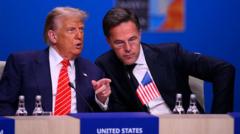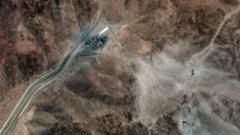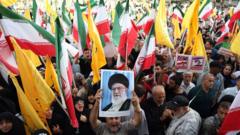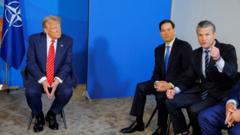The CIA's John Ratcliffe stated that US strikes have significantly damaged Iran's nuclear capabilities, although a leaked intelligence assessment indicated core components remain intact. President Trump backed Ratcliffe's claims while expressing frustration over media interpretations of the events.
CIA Claims Significant Damage to Iran's Nuclear Program Amid Conflicting Intelligence Reports
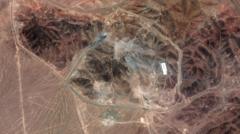
CIA Claims Significant Damage to Iran's Nuclear Program Amid Conflicting Intelligence Reports
The CIA director asserts that recent US military strikes have severely impacted Iran's nuclear facilities, while a leaked Pentagon report suggests otherwise.
The head of the CIA, John Ratcliffe, has publicly stated that recent US military strikes have "severely damaged" Iran's nuclear facilities, claiming they have set the program back by years. This announcement comes in stark contrast to a leaked preliminary assessment from the Pentagon’s intelligence agency, which suggested that while damage occurred, key components of Iran's nuclear infrastructure remained intact after the attacks.
Following the strikes, President Donald Trump emphasized the effectiveness of the military operations, calling them an "obliteration" of Iran's nuclear capabilities. On social media, Trump criticized the media's portrayal of the strike's outcomes, labeling it as "fake news" and asserting that the reports misrepresented the results. He anticipates a press conference from top military officials to discuss the situation and defend the integrity of US efforts in the Middle East.
At a NATO summit in The Hague, Trump expressed that future negotiations with Iran would likely focus on ensuring the country ends its nuclear ambitions. Despite these assertions, Iranian officials have denied any acknowledgment of ongoing negotiations. However, US Middle East envoy Steve Witkoff has indicated that communication, both direct and indirect, is taking place.
Ratcliffe’s remarks included information derived from a historically reliable source, asserting the destruction of several key nuclear facilities, which could result in years of rebuilding efforts if Iran chooses to proceed. The US operations involved a significant military deployment of 125 aircraft targeting Iran's main nuclear sites.
Competing assessments emerged as satellite imagery released later revealed craters at facilities, including Fordo and Isfahan, but questions remain regarding the extent of damage to the underground installations. The Defense Intelligence Agency's leaked report estimated any setbacks to Iran's nuclear program might be minimal, projecting only a few months' delay, an evaluation made with "low confidence."
The Iranian foreign ministry acknowledged that their nuclear installations endured substantial damage, though specific details were withheld. In response, the Israeli Atomic Energy Commission reported that the assault on Fordo had destroyed critical infrastructure, potentially delaying Iran’s nuclear timeline by several years. Conversely, some Iranian officials contended that no irrevocable harm had been inflicted on their nuclear sites, asserting their program remains peaceful while US intelligence previously indicated the absence of an active weapons program.
The ongoing divergence in intelligence assessments highlights the complexities surrounding international military actions, diplomatic discourse, and national security interests concerning Iran’s nuclear aspirations.
Following the strikes, President Donald Trump emphasized the effectiveness of the military operations, calling them an "obliteration" of Iran's nuclear capabilities. On social media, Trump criticized the media's portrayal of the strike's outcomes, labeling it as "fake news" and asserting that the reports misrepresented the results. He anticipates a press conference from top military officials to discuss the situation and defend the integrity of US efforts in the Middle East.
At a NATO summit in The Hague, Trump expressed that future negotiations with Iran would likely focus on ensuring the country ends its nuclear ambitions. Despite these assertions, Iranian officials have denied any acknowledgment of ongoing negotiations. However, US Middle East envoy Steve Witkoff has indicated that communication, both direct and indirect, is taking place.
Ratcliffe’s remarks included information derived from a historically reliable source, asserting the destruction of several key nuclear facilities, which could result in years of rebuilding efforts if Iran chooses to proceed. The US operations involved a significant military deployment of 125 aircraft targeting Iran's main nuclear sites.
Competing assessments emerged as satellite imagery released later revealed craters at facilities, including Fordo and Isfahan, but questions remain regarding the extent of damage to the underground installations. The Defense Intelligence Agency's leaked report estimated any setbacks to Iran's nuclear program might be minimal, projecting only a few months' delay, an evaluation made with "low confidence."
The Iranian foreign ministry acknowledged that their nuclear installations endured substantial damage, though specific details were withheld. In response, the Israeli Atomic Energy Commission reported that the assault on Fordo had destroyed critical infrastructure, potentially delaying Iran’s nuclear timeline by several years. Conversely, some Iranian officials contended that no irrevocable harm had been inflicted on their nuclear sites, asserting their program remains peaceful while US intelligence previously indicated the absence of an active weapons program.
The ongoing divergence in intelligence assessments highlights the complexities surrounding international military actions, diplomatic discourse, and national security interests concerning Iran’s nuclear aspirations.

